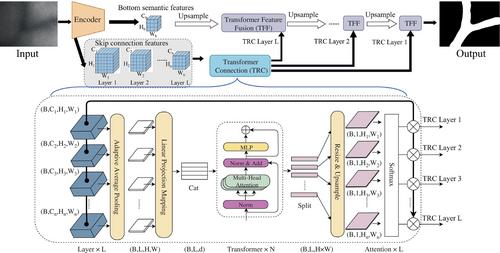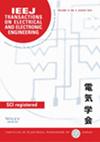下载PDF
{"title":"Transformer Connections: Improving Segmentation in Blurred Near-Infrared Blood Vessel Image in Different Depth","authors":"Jiazhe Wang, Koichi Shimizu, Osamu Yoshie","doi":"10.1002/tee.24146","DOIUrl":null,"url":null,"abstract":"<p>High-fidelity segmentation of blood vessels plays a pivotal role in numerous biomedical applications, such as injection assistance, cancer detection, various surgeries, and vein authentication. Near-infrared (NIR) transillumination imaging is an effective and safe method to visualize the subcutaneous blood vessel network. However, such images are severely blurred because of the light scattering in body tissues. Inspired by the Vision Transformer model, this paper proposes a novel deep learning network known as transformer connection (TRC)-Unet to capture global blurred and local clear correlations while using multi-layer attention. Our method mainly consists of two blocks, thereby aiming to remap skip connection information flow and fuse different domain features. Specifically, the TRC extracts global blurred information from multiple layers and suppresses scattering to increase the clarity of vessel features. Transformer feature fusion eliminates the domain gap between the highly semantic feature maps of the convolutional neural network backbone and the adaptive self-attention maps of TRCs. Benefiting from the long-range dependencies of transformers, we achieved competitive results in relation to various competing methods on different data sets, including retinal vessel segmentation, simulated blur image segmentation, and real NIR blood vessel image segmentation. Moreover, our method remarkably improved the segmentation results of simulated blur image data sets and a real NIR vessel image data set. The quantitative results of ablation studies and visualizations are also reported to demonstrate the superiority of the TRC-Unet design. © 2024 The Author(s). <i>IEEJ Transactions on Electrical and Electronic Engineering</i> published by Institute of Electrical Engineers of Japan and Wiley Periodicals LLC.</p>","PeriodicalId":13435,"journal":{"name":"IEEJ Transactions on Electrical and Electronic Engineering","volume":"19 11","pages":"1828-1841"},"PeriodicalIF":1.0000,"publicationDate":"2024-06-24","publicationTypes":"Journal Article","fieldsOfStudy":null,"isOpenAccess":false,"openAccessPdf":"https://onlinelibrary.wiley.com/doi/epdf/10.1002/tee.24146","citationCount":"0","resultStr":null,"platform":"Semanticscholar","paperid":null,"PeriodicalName":"IEEJ Transactions on Electrical and Electronic Engineering","FirstCategoryId":"5","ListUrlMain":"https://onlinelibrary.wiley.com/doi/10.1002/tee.24146","RegionNum":4,"RegionCategory":"工程技术","ArticlePicture":[],"TitleCN":null,"AbstractTextCN":null,"PMCID":null,"EPubDate":"","PubModel":"","JCR":"Q4","JCRName":"ENGINEERING, ELECTRICAL & ELECTRONIC","Score":null,"Total":0}
引用次数: 0
引用
批量引用
Abstract
High-fidelity segmentation of blood vessels plays a pivotal role in numerous biomedical applications, such as injection assistance, cancer detection, various surgeries, and vein authentication. Near-infrared (NIR) transillumination imaging is an effective and safe method to visualize the subcutaneous blood vessel network. However, such images are severely blurred because of the light scattering in body tissues. Inspired by the Vision Transformer model, this paper proposes a novel deep learning network known as transformer connection (TRC)-Unet to capture global blurred and local clear correlations while using multi-layer attention. Our method mainly consists of two blocks, thereby aiming to remap skip connection information flow and fuse different domain features. Specifically, the TRC extracts global blurred information from multiple layers and suppresses scattering to increase the clarity of vessel features. Transformer feature fusion eliminates the domain gap between the highly semantic feature maps of the convolutional neural network backbone and the adaptive self-attention maps of TRCs. Benefiting from the long-range dependencies of transformers, we achieved competitive results in relation to various competing methods on different data sets, including retinal vessel segmentation, simulated blur image segmentation, and real NIR blood vessel image segmentation. Moreover, our method remarkably improved the segmentation results of simulated blur image data sets and a real NIR vessel image data set. The quantitative results of ablation studies and visualizations are also reported to demonstrate the superiority of the TRC-Unet design. © 2024 The Author(s). IEEJ Transactions on Electrical and Electronic Engineering published by Institute of Electrical Engineers of Japan and Wiley Periodicals LLC.
变压器连接:改善不同深度模糊近红外血管图像的分割效果
血管的高保真分割在注射辅助、癌症检测、各种手术和静脉认证等众多生物医学应用中发挥着举足轻重的作用。近红外透射成像是一种可视化皮下血管网络的有效而安全的方法。然而,由于人体组织中的光散射,此类图像非常模糊。受视觉变压器模型的启发,本文提出了一种称为变压器连接(TRC)-Unet 的新型深度学习网络,在使用多层注意的同时捕捉全局模糊和局部清晰的相关性。我们的方法主要由两部分组成,旨在重新映射跳过连接信息流并融合不同领域的特征。具体来说,TRC 从多层提取全局模糊信息,并抑制散射以提高血管特征的清晰度。变换器特征融合消除了卷积神经网络骨干的高语义特征图与 TRC 的自适应自注意图之间的领域差距。得益于变换器的长程依赖性,我们在不同的数据集(包括视网膜血管分割、模拟模糊图像分割和真实近红外血管图像分割)上取得了优于各种竞争方法的结果。此外,我们的方法明显改善了模拟模糊图像数据集和真实近红外血管图像数据集的分割结果。我们还报告了消融研究和可视化的定量结果,以证明 TRC-Unet 设计的优越性。© 2024 The Author(s).IEEJ Transactions on Electrical and Electronic Engineering 由日本电气工程师学会和 Wiley Periodicals LLC 出版。
本文章由计算机程序翻译,如有差异,请以英文原文为准。


 求助内容:
求助内容: 应助结果提醒方式:
应助结果提醒方式:


